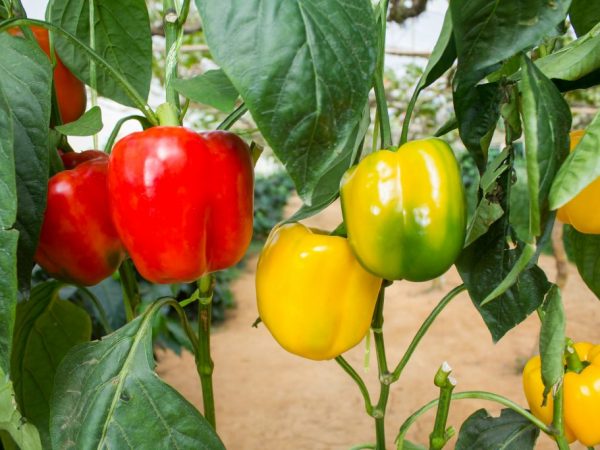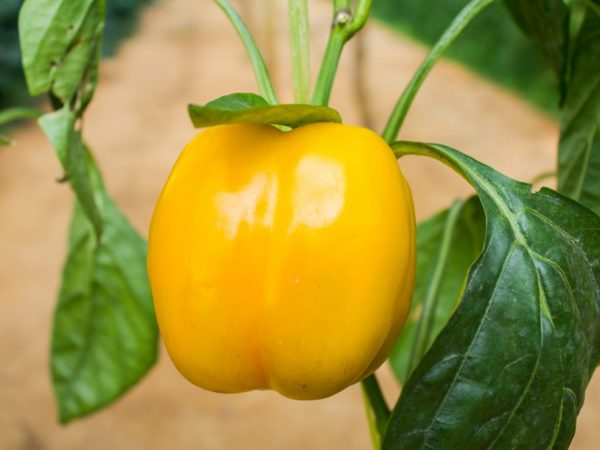Characteristics of productive varieties of pepper
Among the large number of varieties of sweet and bitter peppers, one can single out the main favorites, which have already managed to recommend themselves among experienced gardeners. Detailed descriptions will help you choose fruitful pepper varieties that can satisfy all your requirements.

Characteristics of productive varieties of pepper
Sweet pepper varieties
Among the highest-yielding peppers, it is worth highlighting the representatives of domestic selection.
They are bred taking into account the peculiarities of the climate and are able to delight with a rich harvest with simple care and growing under unstable weather conditions.
Red giant
A thick-walled large-fruited variety of the mid-early ripening period. Bush 50-60 cm high with thick and sturdy stems. On it 10-12 fruits are stably tied, which reach technical ripeness in 2-2.5 months from transplanting.
The fruits of the Red Giant grow up to 0.6 kg in weight, the average weight of peppers is 200-280 g. They have a neat prismatic shape with well-defined four chambers. Ripe fruit walls are up to 10 mm thick. The pulp is deep red in color with a dense structure, crispy and juicy with a good sweetish taste.
Benefits
- undemanding to soil;
- high-yielding (7-10 kg / sq. m);
- transportable and resistant to mechanical damage;
- can be stored for more than 2 weeks in a refrigerator;
- resistant to top rot and fusarium.
Seeds of this variety are sown for seedlings in March-April. The bushes of the Red Giant are best grown in greenhouses, but in open beds it will also surprise you with its quality and productivity.
Moneybags
This is one of the most productive varieties of peppers in the Siberian collection. It has a high yield in the open field, even in regions of risky agriculture with difficult climatic conditions for this crop. Stably forms and does not throw off the ovary in conditions of lower temperatures.
Bush 50-65 cm, requires a garter to the support. On the stems 12-15 fruits are tied, which enter the stage of biological maturity after 135-150 days from germination. Fruits are red, even cubic with thick juicy walls 7-8 mm. They belong to large-fruited with a mass of 220-250 g.
Benefits
- high productivity in unstable weather conditions;
- suitable for thickened plantings (4-6 bushes per 1 sq. m.);
- tolerates short-term cold snaps up to 10-12 ° С.
It is necessary to sow seeds of the Tolstosum variety for seedlings in late February - early March. Planting seedlings in the ground is carried out in May, when the soil warms up to 10 ° C.
Lilac Mist F1
A hybrid of domestic selection, at the stage of technical maturity, it has a purple color, and when it ripens completely becomes red. This is a mid-season (230-145 days) high-yielding hybrid that has worked well for growing in the Moscow region and other regions of the middle lane.
Bushes grow up to 0.9-1 m in height, with a powerful central stem. The peppers are not large, 110-120 g, but a high rate is achieved due to the formation of a large number of fruits on one plant, about 20 fruits are tied.They have a pyramidal shape with a blunt end, 4 chambers. In cooking, it has a universal purpose, suitable for salads and processing.
Alba

The Alba variety is distinguished by its yield
A high-yielding sweet pepper variety. Suitable for growing in all regions in the middle lane and the Moscow region, it shows record yields. Refers to medium early, begins to ripen in 125-135 days from the moment of mass shoots. Bushes up to 0.7 m high, medium leafy. The plants are powerful, but due to the large number of fruits that are tied on it, they require support.
Fruit characteristics:
- weight 180-200 g;
- dimensions 8-9x6 cm;
- conical shape, triangular;
- mesocarp 6-8 mm;
- color from cream to orange-red;
- the surface is smooth, shiny;
- the pulp is dense, crispy.
Alba is super-yielding, 2.5-4 kg of fruits are harvested from one bush, when 4-5 bushes are planted per 1 sq. m. the average yield is 15 kg per 1 sq. m. m.
Other productive varieties
Among the fruitful ones you can also distinguish:
- Big fight;
- Belozerka;
- Atlant;
- Eroshka;
- Derby;
- Gingerbread man.
They bear fruit stably, set a large number of fruits, are well adapted to changes in weather conditions and show resistance to various types of diseases.
Hot pepper varieties
Super-yielding varieties will allow you to grow a sufficient amount of hot peppers on several bushes.
Haifi F1
This Dutch bred hybrid is suitable for any growing method. Haifi can be planted in film tunnels, in open beds and in greenhouses. The bush grows powerful, with dense foliage. A large number of fruits are tied on it, which gradually ripen, the harvest can be harvested from June to the first frost.
Fruits are even, 10-12 cm long, 2-3 cm in diameter, conical in shape from light green to red. Productivity 3-4 kg / sq. m. in the open field. They have a pungent spicy taste, the pungency increases with maturation. It is used dried as a seasoning, canned and added fresh when preparing dishes.
Shakira f1
One of the most productive early-ripening hot peppers is suitable for outdoor cultivation. The first fruits begin to ripen two months after sowing the seeds. The bushes of this variety grow of medium height with a large number of leaves, which protects the fruits from sunburn.
Fruits are red, 16-18 cm long, 3-4 cm in diameter, with a regular conical shape. For the season from 1 sq. m. you can collect 5-5.5 kg of hot peppers. Ripen gradually in separate batches. Shakira is resistant to tobacco mosaic and is rarely affected by pests.
Black Lightning
An early ripe hybrid of Russian selection. It differs among other hot peppers in a dark purple almost black color and large cone-shaped fruits weighing 80-120 g. The fruiting period is long. Ripen amicably in several visits per season. It has a medium-spicy taste, on the Scoville scale it has 750-1000 points. Suitable for fresh consumption, sauces, cooking. Designed for cultivation in greenhouses and on unprotected ground.
Benefits
- high productivity (2-2.5 kg per bush);
- endurance in difficult weather conditions;
- resistance to fungal diseases (white rot, black leg, fusarium).
Seeds are sown for seedlings in April to a depth of 3-4 cm.
They are planted in the beds and in the greenhouse in May. It can be cultivated as perennial plants, by removing the bushes in the fall before the frost begins in a cool room with a temperature of 5-10 ° C, and in the spring they can be planted again in the garden.
Conclusion
The wide assortment of seeds presented on the modern seed market allows you to choose varieties that will delight you with a high yield and surprise with taste, beautiful shape and color. They will provide a large amount of vegetables even on small land plots. And also suitable for farm and industrial cultivation.


